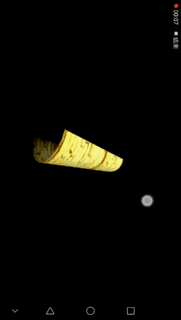本文实例为大家分享了android使用OPENGL ES绘制圆柱体的具体代码,供大家参考,具体内容如下
效果图:

编写jiem.java
*指定屏幕所要显示的假面,并对见、界面进行相关设置
*为Activity设置恢复处理,当Acitvity恢复设置时显示界面同样应该恢复
*当Activity暂停设置时,显示界面同样应该暂停
|
1
2
3
4
5
6
7
8
9
10
11
12
13
14
15
16
17
18
19
20
21
22
23
24
25
26
27
28
29
30
31
32
33
34
35
36
37
38
39
40
41
|
package com.scout.eeeeeee;import android.app.Activity;import android.os.Bundle;import android.app.Activity;import android.os.Bundle;import android.app.Activity;import android.content.pm.ActivityInfo;import android.os.Bundle;import android.view.Window;import android.view.WindowManager;public class jiem extends Activity { private MyGLSurfaceView mGLSurfaceView; /** Called when the activity is first created. */ @Override public void onCreate(Bundle savedInstanceState) { super.onCreate(savedInstanceState); requestWindowFeature(Window.FEATURE_NO_TITLE); getWindow().setFlags(WindowManager.LayoutParams.FLAG_FULLSCREEN, WindowManager.LayoutParams.FLAG_FULLSCREEN); setRequestedOrientation(ActivityInfo.SCREEN_ORIENTATION_LANDSCAPE); mGLSurfaceView = new MyGLSurfaceView(this); setContentView(mGLSurfaceView); mGLSurfaceView.setFocusableInTouchMode(true);//设置为可触控 mGLSurfaceView.requestFocus();//获取焦点 } @Override protected void onResume() { super.onResume(); mGLSurfaceView.onResume(); } @Override protected void onPause() { super.onPause(); mGLSurfaceView.onPause(); }} |
编写MyGLSurfaceView.java实现场景加载和渲染功能
|
1
2
3
4
5
6
7
8
9
10
11
12
13
14
15
16
17
18
19
20
21
22
23
24
25
26
27
28
29
30
31
32
33
34
35
36
37
38
39
40
41
42
43
44
45
46
47
48
49
50
51
52
53
54
55
56
57
58
59
60
61
62
63
64
65
66
67
68
69
70
71
72
73
74
75
76
77
78
79
80
81
82
83
84
85
86
87
88
89
90
91
92
93
94
95
96
97
98
99
100
101
102
103
104
105
106
107
108
109
110
111
112
113
114
115
116
117
118
119
120
121
122
123
124
125
126
127
128
129
130
131
132
133
134
135
136
137
138
139
140
141
142
143
144
145
146
147
148
149
150
151
152
153
154
155
156
157
158
159
160
161
162
163
164
165
166
167
168
169
170
171
172
173
174
175
176
177
178
179
180
181
182
183
184
185
186
187
188
189
190
191
192
193
194
195
196
197
198
199
|
package com.scout.eeeeeee;/** * Created by liuguodong on 2017/10/29. */import java.io.IOException;import java.io.InputStream;import android.opengl.GLSurfaceView;import android.opengl.GLUtils;import javax.microedition.khronos.egl.EGLConfig;import javax.microedition.khronos.opengles.GL10;import javax.microedition.khronos.opengles.GL11;import android.content.Context;import android.graphics.Bitmap;import android.graphics.BitmapFactory;import android.view.MotionEvent;public class MyGLSurfaceView extends GLSurfaceView { private final float suo = 180.0f/320;//角度缩放比例 private SceneRenderer mRenderer;//场景渲染器 private float shangY;//上次的触控位置Y坐标 private float shangX;//上次的触控位置Y坐标 private int lightAngle=90;//灯的当前角度 public MyGLSurfaceView(Context context) { super(context); mRenderer = new SceneRenderer(); //创建场景渲染器 setRenderer(mRenderer); //设置渲染器 setRenderMode(GLSurfaceView.RENDERMODE_CONTINUOUSLY);//设置渲染模式为主动渲染 } //触摸事件回调方法 @Override public boolean onTouchEvent(MotionEvent e) { float y = e.getY(); float x = e.getX(); switch (e.getAction()) { case MotionEvent.ACTION_MOVE: float dy = y - shangY;//计算触控笔Y位移 float dx = x - shangX;//计算触控笔Y位移 mRenderer.cylinder.mAngleX += dy * suo;//设置沿x轴旋转角度 mRenderer.cylinder.mAngleZ += dx * suo;//设置沿z轴旋转角度 requestRender();//重绘画面 } shangY = y;//记录触控笔位置 shangX = x;//记录触控笔位置 return true; } private class SceneRenderer implements GLSurfaceView.Renderer { int textureId;//纹理名称ID zhuCH cylinder;//创建圆柱体 public SceneRenderer() { } public void onDrawFrame(GL10 gl) { //清除颜色缓存 gl.glClear(GL10.GL_COLOR_BUFFER_BIT | GL10.GL_DEPTH_BUFFER_BIT); //设置当前矩阵为模式矩阵 gl.glMatrixMode(GL10.GL_MODELVIEW); //设置当前矩阵为单位矩阵 gl.glLoadIdentity(); gl.glPushMatrix();//保护变换矩阵现场 float lx=0; //设定光源的位置 float ly=(float)(7*Math.cos(Math.toRadians(lightAngle))); float lz=(float)(7*Math.sin(Math.toRadians(lightAngle))); float[] positionParamsRed={lx,ly,lz,0}; gl.glLightfv(GL10.GL_LIGHT1, GL10.GL_POSITION, positionParamsRed,0); initMaterial(gl);//初始化纹理 gl.glTranslatef(0, 0, -10f);//平移 initLight(gl);//开灯 cylinder.drawSelf(gl);//绘制 closeLight(gl);//关灯 gl.glPopMatrix();//恢复变换矩阵现场 } public void onSurfaceChanged(GL10 gl, int width, int height) { //设置视窗大小及位置 gl.glViewport(0, 0, width, height); //设置当前矩阵为投影矩阵 gl.glMatrixMode(GL10.GL_PROJECTION); //设置当前矩阵为单位矩阵 gl.glLoadIdentity(); //计算透视投影的比例 float ratio = (float) width / height; //调用此方法计算产生透视投影矩阵 gl.glFrustumf(-ratio, ratio, -1, 1, 1, 100); } public void onSurfaceCreated(GL10 gl, EGLConfig config) { //关闭抗抖动 gl.glDisable(GL10.GL_DITHER); //设置特定Hint项目的模式,这里为设置为使用快速模式 gl.glHint(GL10.GL_PERSPECTIVE_CORRECTION_HINT,GL10.GL_FASTEST); //设置屏幕背景色黑色RGBA gl.glClearColor(0,0,0,0); //设置着色模型为平滑着色 gl.glShadeModel(GL10.GL_SMOOTH); //启用深度测试 gl.glEnable(GL10.GL_DEPTH_TEST); textureId=initTexture(gl,R.drawable.stone);//纹理ID cylinder=new zhuCH(10f,2f,18f,textureId);//创建圆柱体 } } //初始化白色灯 private void initLight(GL10 gl) { gl.glEnable(GL10.GL_LIGHTING);//允许光照 gl.glEnable(GL10.GL_LIGHT1);//打开1号灯 //环境光设置 float[] ambientParams={0.2f,0.2f,0.2f,1.0f};//光参数 RGBA gl.glLightfv(GL10.GL_LIGHT1, GL10.GL_AMBIENT, ambientParams,0); //散射光设置 float[] diffuseParams={1f,1f,1f,1.0f};//光参数 RGBA gl.glLightfv(GL10.GL_LIGHT1, GL10.GL_DIFFUSE, diffuseParams,0); //反射光设置 float[] specularParams={1f,1f,1f,1.0f};//光参数 RGBA gl.glLightfv(GL10.GL_LIGHT1, GL10.GL_SPECULAR, specularParams,0); } //关闭灯 private void closeLight(GL10 gl) { gl.glDisable(GL10.GL_LIGHT1); gl.glDisable(GL10.GL_LIGHTING); } //初始化材质 private void initMaterial(GL10 gl) { //环境光 float ambientMaterial[] = {248f/255f, 242f/255f, 144f/255f, 1.0f}; gl.glMaterialfv(GL10.GL_FRONT_AND_BACK, GL10.GL_AMBIENT, ambientMaterial,0); //散射光 float diffuseMaterial[] = {248f/255f, 242f/255f, 144f/255f, 1.0f}; gl.glMaterialfv(GL10.GL_FRONT_AND_BACK, GL10.GL_DIFFUSE, diffuseMaterial,0); //高光材质 float specularMaterial[] = {248f/255f, 242f/255f, 144f/255f, 1.0f}; gl.glMaterialfv(GL10.GL_FRONT_AND_BACK, GL10.GL_SPECULAR, specularMaterial,0); gl.glMaterialf(GL10.GL_FRONT_AND_BACK, GL10.GL_SHININESS, 100.0f); } //初始化纹理 public int initTexture(GL10 gl,int drawableId)//textureId { //生成纹理ID int[] textures = new int[1]; gl.glGenTextures(1, textures, 0); int currTextureId=textures[0]; gl.glBindTexture(GL10.GL_TEXTURE_2D, currTextureId); gl.glTexParameterf(GL10.GL_TEXTURE_2D, GL10.GL_TEXTURE_MIN_FILTER,GL10.GL_LINEAR_MIPMAP_NEAREST); gl.glTexParameterf(GL10.GL_TEXTURE_2D,GL10.GL_TEXTURE_MAG_FILTER,GL10.GL_LINEAR_MIPMAP_LINEAR); ((GL11)gl).glTexParameterf(GL10.GL_TEXTURE_2D, GL11.GL_GENERATE_MIPMAP, GL10.GL_TRUE); gl.glTexParameterf(GL10.GL_TEXTURE_2D, GL10.GL_TEXTURE_WRAP_S,GL10.GL_REPEAT); gl.glTexParameterf(GL10.GL_TEXTURE_2D, GL10.GL_TEXTURE_WRAP_T,GL10.GL_REPEAT); InputStream is = this.getResources().openRawResource(drawableId); Bitmap bitmapTmp; try { bitmapTmp = BitmapFactory.decodeStream(is); } finally { try { is.close(); } catch(IOException e) { e.printStackTrace(); } } GLUtils.texImage2D(GL10.GL_TEXTURE_2D, 0, bitmapTmp, 0); bitmapTmp.recycle(); return currTextureId; }} |
编写zgyCH.java
*设置圆柱体的控制属性,主要包括纹理、高度、截面半径、截面角度切分单位和高度切分单位,这些属性用于控制圆柱体的大小
*定义各个圆柱体绘制类的三角形绘制方法和工具方法
*实现圆柱体的线性会执法,线性会执法和三角形会执法顶点的获取方法相同,只是采用的绘制顶点顺序和渲染方法不同,并且先行绘制没有光照和纹理贴图
|
1
2
3
4
5
6
7
8
9
10
11
12
13
14
15
16
17
18
19
20
21
22
23
24
25
26
27
28
29
30
31
32
33
34
35
36
37
38
39
40
41
42
43
44
45
46
47
48
49
50
51
52
53
54
55
56
57
58
59
60
61
62
63
64
65
66
67
68
69
70
71
72
73
74
75
76
77
78
79
80
81
82
83
84
85
86
87
88
89
90
91
92
93
94
95
96
97
98
99
100
101
102
103
104
105
106
107
108
109
110
111
112
113
114
115
116
117
118
119
120
121
122
123
124
125
126
127
128
129
130
131
132
133
134
135
136
137
138
139
140
141
142
143
144
145
146
147
148
149
150
151
152
153
154
155
156
157
158
159
160
161
162
163
164
165
166
167
168
169
170
171
172
173
174
175
176
177
178
179
180
181
182
183
184
185
186
187
188
189
190
191
192
193
194
195
196
197
198
199
200
201
202
203
204
205
206
207
208
209
210
211
|
package com.scout.eeeeeee;/** * Created by liuguodong on 2017/10/29. */import java.nio.ByteBuffer;import java.nio.ByteOrder;import java.nio.FloatBuffer;import java.util.ArrayList;import javax.microedition.khronos.opengles.GL10;public class zhuCH{ private FloatBuffer dingBuffer;//顶点坐标缓冲 private FloatBuffer myNormalBuffer;//向量缓冲 private FloatBuffer myTexture;//纹理缓冲 int textureId; int vCount;//顶点数量 float length;//圆柱长度 float circle_radius;//圆截环半径 float degreespan; //圆截环每一份的度数大小 public float mAngleX; public float mAngleY; public float mAngleZ; public zhuCH(float length,float circle_radius,float degreespan,int textureId) { this.circle_radius=circle_radius; this.length=length; this.degreespan=degreespan; this.textureId=textureId; float collength=(float)length;//圆柱每块所占的长度 int spannum=(int)(360.0f/degreespan); ArrayList<Float> val=new ArrayList<Float>();//顶点存放列表 ArrayList<Float> ial=new ArrayList<Float>();//法向量存放列表 for(float circle_degree=180.0f;circle_degree>0.0f;circle_degree-=degreespan)//循环行 { float x1 =(float)(-length/2); float y1=(float) (circle_radius*Math.sin(Math.toRadians(circle_degree))); float z1=(float) (circle_radius*Math.cos(Math.toRadians(circle_degree))); float a1=0; float b1=y1; float c1=z1; float l1=getVectorLength(a1, b1, c1);//模长 a1=a1/l1;//法向量规格化 b1=b1/l1; c1=c1/l1; float x2 =(float)(-length/2); float y2=(float) (circle_radius*Math.sin(Math.toRadians(circle_degree-degreespan))); float z2=(float) (circle_radius*Math.cos(Math.toRadians(circle_degree-degreespan))); float a2=0; float b2=y2; float c2=z2; float l2=getVectorLength(a2, b2, c2);//模长 a2=a2/l2;//法向量规格化 b2=b2/l2; c2=c2/l2; float x3 =(float)(length/2); float y3=(float) (circle_radius*Math.sin(Math.toRadians(circle_degree-degreespan))); float z3=(float) (circle_radius*Math.cos(Math.toRadians(circle_degree-degreespan))); float a3=0; float b3=y3; float c3=z3; float l3=getVectorLength(a3, b3, c3);//模长 a3=a3/l3;//法向量规格化 b3=b3/l3; c3=c3/l3; float x4 =(float)(length/2); float y4=(float) (circle_radius*Math.sin(Math.toRadians(circle_degree))); float z4=(float) (circle_radius*Math.cos(Math.toRadians(circle_degree))); float a4=0; float b4=y4; float c4=z4; float l4=getVectorLength(a4, b4, c4);//模长 a4=a4/l4;//法向量规格化 b4=b4/l4; c4=c4/l4; val.add(x1);val.add(y1);val.add(z1);//两个三角形,共6个顶点的坐标 val.add(x2);val.add(y2);val.add(z2); val.add(x4);val.add(y4);val.add(z4); val.add(x2);val.add(y2);val.add(z2); val.add(x3);val.add(y3);val.add(z3); val.add(x4);val.add(y4);val.add(z4); ial.add(a1);ial.add(b1);ial.add(c1);//顶点对应的法向量 ial.add(a2);ial.add(b2);ial.add(c2); ial.add(a4);ial.add(b4);ial.add(c4); ial.add(a2);ial.add(b2);ial.add(c2); ial.add(a3);ial.add(b3);ial.add(c3); ial.add(a4);ial.add(b4);ial.add(c4); } vCount=val.size()/3;//确定顶点数量 //顶点 float[] vertexs=new float[vCount*3]; for(int i=0;i<vCount*3;i++) { vertexs[i]=val.get(i); } ByteBuffer vbb=ByteBuffer.allocateDirect(vertexs.length*4); vbb.order(ByteOrder.nativeOrder()); dingBuffer=vbb.asFloatBuffer(); dingBuffer.put(vertexs); dingBuffer.position(0); //法向量 float[] normals=new float[vCount*3]; for(int i=0;i<vCount*3;i++) { normals[i]=ial.get(i); } ByteBuffer ibb=ByteBuffer.allocateDirect(normals.length*4); ibb.order(ByteOrder.nativeOrder()); myNormalBuffer=ibb.asFloatBuffer(); myNormalBuffer.put(normals); myNormalBuffer.position(0); //纹理 float[] textures=generateTexCoor(spannum); ByteBuffer tbb=ByteBuffer.allocateDirect(textures.length*4); tbb.order(ByteOrder.nativeOrder()); myTexture=tbb.asFloatBuffer(); myTexture.put(textures); myTexture.position(0); } public void drawSelf(GL10 gl) { gl.glRotatef(mAngleX, 1, 0, 0);//旋转 gl.glRotatef(mAngleY, 0, 1, 0); gl.glRotatef(mAngleZ, 0, 0, 1); gl.glEnableClientState(GL10.GL_VERTEX_ARRAY);//打开顶点缓冲 gl.glVertexPointer(3, GL10.GL_FLOAT, 0, dingBuffer);//指定顶点缓冲 gl.glEnableClientState(GL10.GL_NORMAL_ARRAY);//打开法向量缓冲 gl.glNormalPointer(GL10.GL_FLOAT, 0, myNormalBuffer);//指定法向量缓冲 gl.glEnable(GL10.GL_TEXTURE_2D); gl.glEnableClientState(GL10.GL_TEXTURE_COORD_ARRAY); gl.glTexCoordPointer(2, GL10.GL_FLOAT, 0, myTexture); gl.glBindTexture(GL10.GL_TEXTURE_2D, textureId); gl.glDrawArrays(GL10.GL_TRIANGLES, 0, vCount);//绘制图像 gl.glDisableClientState(GL10.GL_TEXTURE_COORD_ARRAY);//关闭缓冲 gl.glEnable(GL10.GL_TEXTURE_2D); gl.glDisableClientState(GL10.GL_VERTEX_ARRAY); gl.glDisableClientState(GL10.GL_NORMAL_ARRAY); } //法向量规格化,求模长度 public float getVectorLength(float x,float y,float z) { float pingfang=x*x+y*y+z*z; float length=(float) Math.sqrt(pingfang); return length; } //自动切分纹理产生纹理数组的方法 public float[] generateTexCoor(int bh) { float[] result=new float[bh*6*2]; float REPEAT=2; float sizeh=1.0f/bh;//行数 int c=0; for(int i=0;i<bh;i++) { //每行列一个矩形,由两个三角形构成,共六个点,12个纹理坐标 float t=i*sizeh; result[c++]=0; result[c++]=t; result[c++]=0; result[c++]=t+sizeh; result[c++]=REPEAT; result[c++]=t; result[c++]=0; result[c++]=t+sizeh; result[c++]=REPEAT; result[c++]=t+sizeh; result[c++]=REPEAT; result[c++]=t; } return result; }} |
以上就是本文的全部内容,希望对大家的学习有所帮助,也希望大家多多支持服务器之家。
原文链接:https://blog.csdn.net/liu3364575/article/details/78384170














